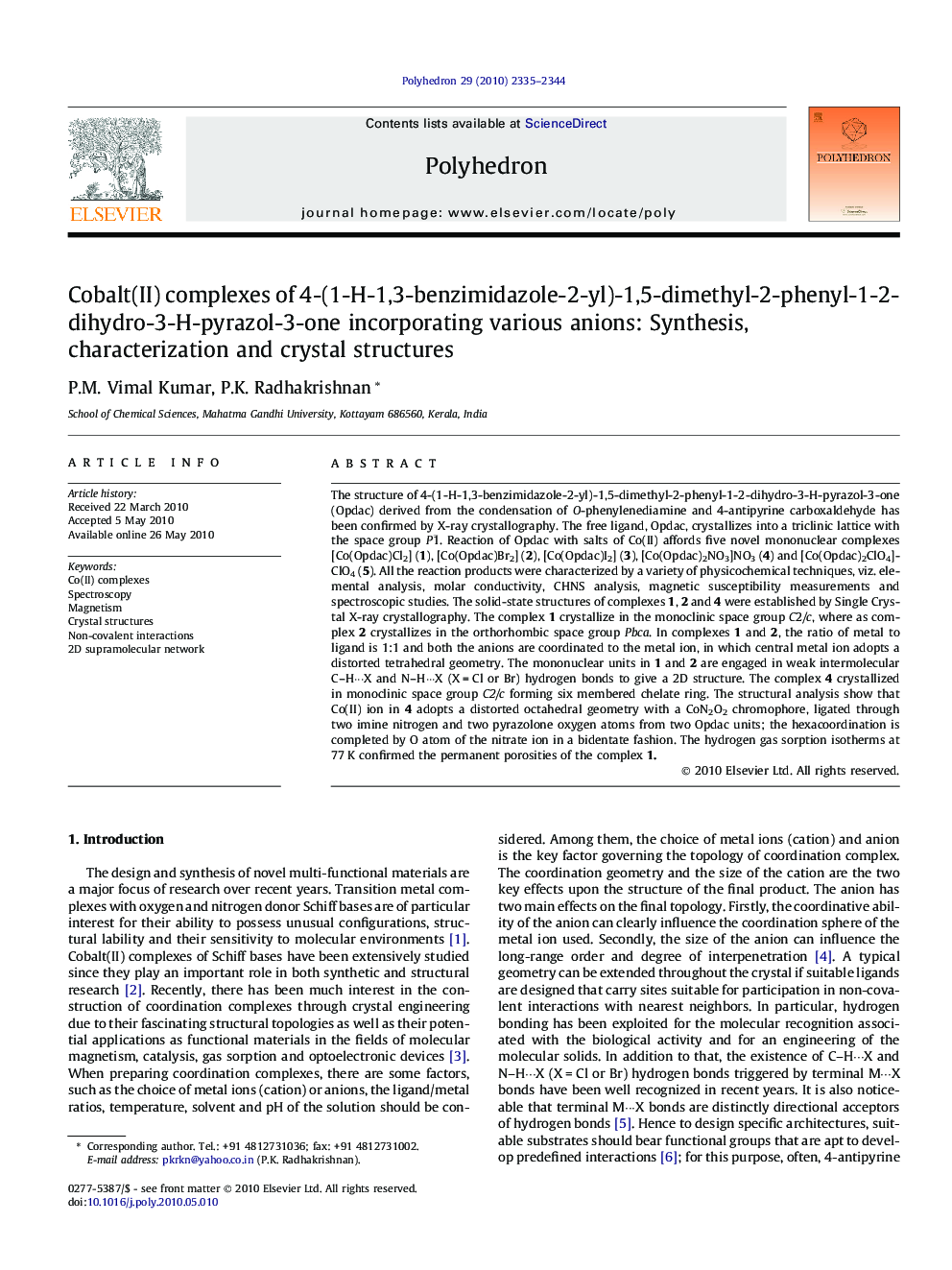| کد مقاله | کد نشریه | سال انتشار | مقاله انگلیسی | نسخه تمام متن |
|---|---|---|---|---|
| 1336685 | 979603 | 2010 | 10 صفحه PDF | دانلود رایگان |

The structure of 4-(1-H-1,3-benzimidazole-2-yl)-1,5-dimethyl-2-phenyl-1-2-dihydro-3-H-pyrazol-3-one (Opdac) derived from the condensation of O -phenylenediamine and 4-antipyrine carboxaldehyde has been confirmed by X-ray crystallography. The free ligand, Opdac, crystallizes into a triclinic lattice with the space group P1¯. Reaction of Opdac with salts of Co(II) affords five novel mononuclear complexes [Co(Opdac)Cl2] (1), [Co(Opdac)Br2] (2), [Co(Opdac)I2] (3), [Co(Opdac)2NO3]NO3 (4) and [Co(Opdac)2ClO4]ClO4 (5). All the reaction products were characterized by a variety of physicochemical techniques, viz. elemental analysis, molar conductivity, CHNS analysis, magnetic susceptibility measurements and spectroscopic studies. The solid-state structures of complexes 1, 2 and 4 were established by Single Crystal X-ray crystallography. The complex 1 crystallize in the monoclinic space group C2/c, where as complex 2 crystallizes in the orthorhombic space group Pbca. In complexes 1 and 2, the ratio of metal to ligand is 1:1 and both the anions are coordinated to the metal ion, in which central metal ion adopts a distorted tetrahedral geometry. The mononuclear units in 1 and 2 are engaged in weak intermolecular C–H···X and N–H···X (X = Cl or Br) hydrogen bonds to give a 2D structure. The complex 4 crystallized in monoclinic space group C2/c forming six membered chelate ring. The structural analysis show that Co(II) ion in 4 adopts a distorted octahedral geometry with a CoN2O2 chromophore, ligated through two imine nitrogen and two pyrazolone oxygen atoms from two Opdac units; the hexacoordination is completed by O atom of the nitrate ion in a bidentate fashion. The hydrogen gas sorption isotherms at 77 K confirmed the permanent porosities of the complex 1.
The present investigation reports the novel synthesis of mononuclear Cobalt(II) complexes [Co(Opdac)Cl2] (1), [Co(Opdac)Br2] (2), [Co(Opdac)I2] (3), [Co(Opdac)2NO3]NO3 (4) and [Co(Opdac)2ClO4]ClO4 (5) with the Schiff base ligand, 4-(1-H-1,3benzimidazole-2-yl)-1,5-imethyl-2-phenyl-1-2-dihydro-3-H-pyrazol-3-one (Opdac) and their characterization. In all the complexes Opdac acts as neutral bidentate ligand forming six membered chelate ring around the central metal ion. X-ray study of complexes 1, 2 and 4 indicates that intermolecular hydrogen bonding interactions play an important role in the different dimensional assembly of these complexes because of the presence of organic ligand and various anions.Figure optionsDownload as PowerPoint slide
Journal: Polyhedron - Volume 29, Issue 11, 28 July 2010, Pages 2335–2344